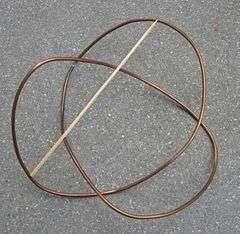Quadrisecant

In geometry, a quadrisecant or quadrisecant line of a curve is a line that passes through four points of the curve.
In knot theory
In three-dimensional Euclidean space, every non-trivial tame knot or link has a quadrisecant. Originally established in the case of knotted polygons and smooth knots by Erika Pannwitz,[1] this result was extended to knots in suitably general position and links with nonzero linking number,[2] and later to all nontrivial tame knots and links.[3]
Pannwitz proved more strongly that the number of distinct quadrisecants is lower bounded by a function of the minimum number of boundary singularities in a locally-flat open disk bounded by the knot.[1][4] Morton & Mond (1982) conjectured that the number of distinct quadrisecants of a given knot is always at least n(n − 1)/2, where n is the crossing number of the knot.[2][4] However, counterexamples to this conjecture have since been discovered.[4]
Two-component links have quadrisecants in which the points on the quadrisecant appear in alternating order between the two components,[2] and nontrivial knots have quadrisecants in which the four points, ordered cyclically as a,b,c,d on the knot, appear in order a,c,b,d along the quadrisecant.[5] The existence of these alternating quadrisecants can be used to derive the Fary–Milnor theorem, a lower bound on the total curvature of a nontrivial knot.[5] Quadrisecants have also been used to find lower bounds on the ropelength of knots.[6]
In algebraic geometry
Arthur Cayley derived a formula for the number of quadrisecants of an algebraic curve in three-dimensional complex projective space, as a function of its degree and genus.[7] For a curve of degree d and genus g, the number of quadrisecants is[8]
Of skew lines
In three-dimensional Euclidean space, every set of four skew lines in general position either has two quadrisecants (also called in this context transversals) or none. Any three of the four lines determine a doubly ruled surface, in which one of the two sets of ruled lines contains the three given lines, and the other ruling consists of trisecants to the given lines. If the fourth of the given lines pierces this surface, its two points of intersection lie on the two quadrisecants; if it is disjoint from the surface, then there are no quadrisecants.[9]
The quadrisecants of sets of lines play an important role in the construction of the Schläfli double six, a configuration of twelve lines intersecting each other in 30 crossings. If five lines ai (for i = 1,2,3,4,5) are given in a three-dimensional space, such that all five are intersected by a common line b6 but are otherwise in general position, then each of the five quadruples of the lines ai has a second quadrisecant bi, and the five lines bi formed in this way are all intersected by a common line a6. These twelve lines and the 30 intersection points aibj form the double six.[10][11]
References
- 1 2 Pannwitz, Erika (1933), "Eine elementargeometrische Eigenschaft von Verschlingungen und Knoten", Mathematische Annalen, 108 (1): 629–672, doi:10.1007/BF01452857 .
- 1 2 3 Morton, Hugh R.; Mond, David M. Q. (1982), "Closed curves with no quadrisecants", Topology, 21: 235–243, doi:10.1016/0040-9383(82)90007-6, MR 0649756 .
- ↑ Kuperberg, Greg (1994), "Quadrisecants of knots and links", Journal of Knot Theory and Its Ramifications, 3: 41–50, arXiv:math/9712205, doi:10.1142/S021821659400006X, MR 1265452 .
- 1 2 3 Jin, Gyo Taek (2005), "Quadrisecants of knots with small crossing number", Physical and numerical models in knot theory (PDF), Ser. Knots Everything, 36, World Sci. Publ., Singapore, pp. 507–523, doi:10.1142/9789812703460_0025, MR 2197955 .
- 1 2 Denne, Elizabeth Jane (2004), Alternating quadrisecants of knots, Ph.D. thesis, University of Illinois at Urbana-Champaign, arXiv:math/0510561, Bibcode:2005math.....10561D .
- ↑ Denne, Elizabeth; Diao, Yuanan; Sullivan, John M. (2006), "Quadrisecants give new lower bounds for the ropelength of a knot", Geometry & Topology, 10: 1–26, arXiv:math/0408026, doi:10.2140/gt.2006.10.1, MR 2207788 .
- ↑ Cayley, Arthur (1863), Philosophical Transactions of the Royal Society of London, 153, pp. 453–483, JSTOR 108806 .
- ↑ Griffiths, Phillip; Harris, Joseph (2011), Principles of Algebraic Geometry, Wiley Classics Library, 52, John Wiley & Sons, p. 296, ISBN 9781118030776 .
- ↑ Hilbert, David; Cohn-Vossen, Stephan (1952), Geometry and the Imagination (2nd ed.), New York: Chelsea, p. 164, ISBN 978-0-8284-1087-8 .
- ↑ Schläfli, Ludwig (1858), Cayley, Arthur, ed., "An attempt to determine the twenty-seven lines upon a surface of the third order, and to derive such surfaces in species, in reference to the reality of the lines upon the surface", Quarterly journal of pure and applied mathematics, 2: 55–65, 110–120 .
- ↑ Coxeter, H. S. M. (2006), "An absolute property of four mutually tangent circles", Non-Euclidean geometries, Math. Appl. (N. Y.), 581, New York: Springer, pp. 109–114, doi:10.1007/0-387-29555-0_5, MR 2191243 . Coxeter repeats Schläfli's construction, and provides several references to simplified proofs of its correctness.
